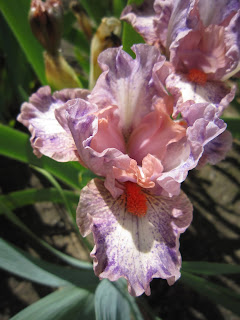by Tom Waters
There are three classes of median irises that span the
interval between the standard dwarf bearded (SDB) and tall bearded (TB)
classes. The intermediate bearded (IB) are mostly the result of crossing TBs
with SDBs, leading to plants intermediate between the two, both in height and
in bloom season. The miniature tall bearded (MTB) come from varied backgrounds,
but must meet exacting standards of delicacy in height, flower size, and stalk
proportions. The final class, the border bearded (BB) are derived almost
exclusively from the TBs, but with height less than the 70 cm (27.5 inches)
that is the boundary between the BB and TB classes.
The BB class is unusual in that it has no real “center of
gravity” of its own; rather it represents the smaller “tail end” of the TB
class. Many BBs are registered at a height of 27 inches, just barely below the
upper limit of the class, and are hard to distinguish in practice from TBs at the
lower end of the TB height range. One might ask if there is really a need to
place such irises in a separate class.
Proponents of BBs have long had a vision of the class that
sets it apart from the TB class. An ideal BB is not just a TB that is an inch
or two shorter; rather, an ideal BB is a reduced TB in all its dimensions and
proportions, including foliage, branching, flower size and form. While it is
not intended that they be as delicate as MTBs, they ought to be “halfway there”,
as it were – they should be esthetically medians, instantly distinguishable as
diminutive and elegant irises in their own right. Part of their value comes
from being useful in garden design in situations where TBs would be out of
scale or overwhelming. They should be more about charm than grandeur.
 |
'Brown Lasso' (Buckles by Niswonger, 1975),
BB (22 inches), American Dykes Medal, 1981 |
Some of the best median hybridizers have pursued this ideal
with great care, selecting plants for introduction that are modestly
proportioned, perky, and might more easily be mistaken for IBs or MTBs than for
TBs. Early BBs like
‘Frenchi’ (B. Jones, 1959) and
‘Tulare’ (M. Hamblen, 1961)
were exemplars of this ideal in their time, as was
‘Brown Lasso’ (Buckles by
Niswonger, 1975) which was the only BB to win the American Dykes Medal.
‘Cranapple’
(Aitken, 1995) is a worthy example of more recent vintage.
This is difficult
work, and not always appreciated; many people buy BBs just as they do TBs, by
looking at the catalog “glamor photos” of single blooms and choosing exciting colors
and patterns, with little attention to plant proportions or esthetics. A large,
blousy iris with the latest TB color pattern that does not meet the BB ideal
may sell more than a carefully selected, lightly ruffled, charming BB in an
unexceptional yellow, violet, or white.
One might argue that this doesn’t matter in the big picture
of things. People like what they like, and if they enjoy an iris, who cares
about its failure to meet some elitist ideal? On a case-by-case basis, I think that is a
valid perspective. Where it becomes problematic is when the notion of the class
becomes so blurred that it ceases to convey anything clear to gardeners, and those
seeking smaller, well-proportioned medians can’t trust the BB designation as
meaningful.
 |
'Oops' (Jim and Vicki Craig, 2003),
a BB from tetraploid MTB breeding |
We all have a role to play in maintaining the
distinctiveness of the BB class. Hybridizers can work more with lines that are
intentionally devised to produce BBs, rather than taking most of their BB
introductions from crosses intended to produce TBs. Tetraploid MTBs and smaller
bearded species can be used to “tame” the TB genes and keep plants in scale.
Judges must strive to be more scrupulous in maintaining the
standards of the BB class. Alas, color novelty and hybridizer reputation often
bias judges away from a more sober consideration of shape and proportion.
Finally, buyers can reward hybridizers who keep the BB ideal
in mind. Best of all is to buy BBs you have seen growing in a garden, and which
you know to be consistently diminutive and in proportion. If you do buy “sight
unseen” (as I often do), give preference to BBs registered in the 20-24 inch
range, rather than 26 or 27 inches, as so many are. I also check pedigrees,
looking for a preponderance of BBs, MTBs, or SPX irises in the background of a
new BB. Finally, even a single-bloom photo can convey information about the
scale of the plant, if you know what to look for. A bloom that is perky,
flared, and not too ruffled is more likely to be in scale than one that is more
flamboyant but not so flaring.
I have chosen not to use this blog post to give examples of
modern BBs that I think are particularly fine or particularly poor examples of
the class ideals; that is for each person to decide for themselves.
The BB class need not be just a spillover for short TB
seedlings; it has much to offer the discerning gardener. Wonderful irises come
in all sizes!
If you found this post interesting, please check back in January, when noted hybridizer Kevin Vaughn offers his reflections on the history of the BB class and promising avenues for its future development.














































